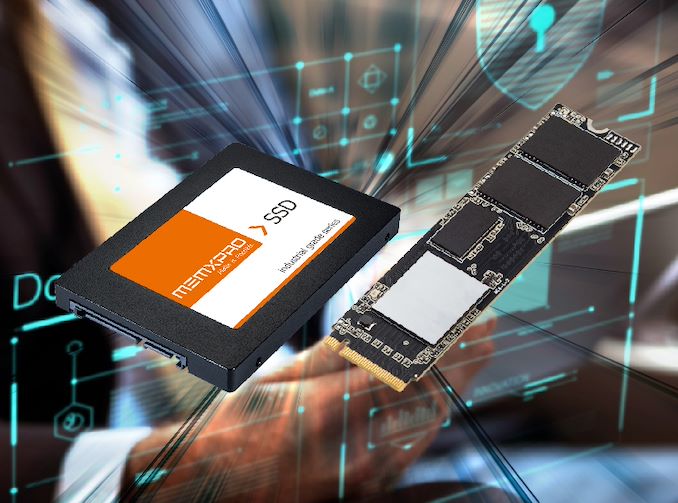What's TLC is SLC Again: MEMXPRO Introduces PC32 Full-Drive Pseudo-SLC SSDs
by Anton Shilov on February 21, 2020 12:00 PM EST
Pseudo-SLC caches for TLC-based SSDs are almost as old as TLC NAND itself, serving as a simple and practical solution to TLC's lower sustained throughput. But like all caches, pseudo-SLC caches have a finite size; and once you run over it, you're back to directly hitting the TLC. So what is a user or system builder to do if they need a drive with SLC-like performance all the time? For a while, the answer to that has been MLC drives, but with MLC slowly but surely on its way out as well, other solutions are needed. And to that end, MEMXPRO is introducing a series of new drives that go the opposite direction, embracing pseudo-SLC mode to its very core by making the entire drive pseudo-SLC.
Based on 64-layer 3D TLC memory, MEMXPRO's PC32 drives use drive-wide pseudo-SLC mode to give the drives MLC-like performance and reliability. This setup is overkill for most applications, but for use cases that require SSDs with long lifespans, and high durability – MEMXPRO's specialty – the PC32 fills an important niche.
The MEMXPRO PC32 drives in are based on the Silicon Motion SM2262EN controller as well as Micron’s B17A 64-layer 3D TLC NAND memory, which is rated for 10,000 P/E cycles. By putting the drives in pseudo-SLC mode, the manufacturer is able to increase their durability to 40,000 P/E cycles, albeit at the cost of capacity. Since TLC NAND that offers 3-bits of storage per cell is otherwise reduced to 1-bit per cell, the drives are available in capacities from just 80 GB to 320 GB. As for throughput, with the high-end controller used for the drive, MEMXPRO has rated the drives' sustained sequential read and write performance 3,250 and 2,980 MB/s respectively, which is in line with other modern SSDs featuring a PCIe 3.0 x4 interface.
Under the hood, MEMXPRO’s PC32 drives are built on PCBs with side fill and under fill protective conformal coating to enhance their reliability. Also, they are designed to ensure reliable performance within industrial temperature ranges (-40°C to +85°C), so the number of applications they can address is wide. Meanwhile, the SM2262EN controller fully supports AES 256-bit encryption with TCG OPAL 2.0 compliance, so the manufacturer can enable this functionality at request with an appropriate firmware. PC32 also supports MEMXPRO’s proprietary mSMART intelligent storage management tool to monitor drive health and lifespan status that warns owner of the drive about increased risks.
MEMXPRO will demonstrate its PC32 and other SSDs at the upcoming Embedded World 2020 trade show later this month, and will start taking orders on the drives shortly. The company has also noted their interest in developing more all-SLC drives, noting that that if the market requires higher-capacity products in a different form-factor, those SSDs could be developed as well.
Related Reading:
- Greenliant Launches EnduroSLC SSDs with Up to 250K P/E Cycles
- Enmotus MiDrive: Rethinking SLC Caching For QLC SSDs
- Toshiba Launches XL-FLASH 3D SLC NAND
- Memblaze’s PBlaze5 X26: Toshiba’s XL-Flash-Based Ultra-Low Latency SSD
- ADATA Launches microSD Cards Based on SLC NAND Memory
- Western Digital Develops Low-Latency Flash to Compete with Intel Optane
Source: MEMXPRO










39 Comments
View All Comments
MASSAMKULABOX - Monday, February 24, 2020 - link
Host managed Buffers ..iirc .. sounds like SAN type stuffmode_13h - Wednesday, February 26, 2020 - link
I'm pretty sure it's something else. This is about the SSD exposing the NAND array and letting the host manage wear-leveling, etc.Soulkeeper - Saturday, February 22, 2020 - link
Here's an idea: put a physical dip switch on the drives, like a backup bios switch on a motherboard, so the user can select SLC or TLC mode. It would be nice to just decide to run your shiny new 2TB drive faster and longer lived at 512GB or 1TB.shelbystripes - Saturday, February 22, 2020 - link
Someone who wants a TLC drive will be better off buying a cheaper TLC drive. Someone who needs SLC-level long-term reliability won’t ever use that kind of toyish “feature”, which sounds like a great way to accidentally wipe the entire drive (by moving the switch) while servicing it.mode_13h - Saturday, February 22, 2020 - link
On the one hand, I wonder why you need DIP switches for that - couldn't it be configured via software?On the other hand, I wonder why stop at DIP switches. Jumpers FTMFW!
Alexvrb - Sunday, February 23, 2020 - link
I miss jumpers.FunBunny2 - Sunday, February 23, 2020 - link
"I miss jumpers."Twiggy made them famous. You do remember Twiggy, right?
tygrus - Sunday, February 23, 2020 - link
?In the future we might have a Controller (host bus between chips) of embedded controllers (embedded with the flash chips inside each flash package). The niche products are for corporate spec junkies with deep products where other options are being ignored.FunBunny2 - Wednesday, February 26, 2020 - link
"The niche products are for corporate spec junkies with deep products where other options are being ignored."I'm more of a mind that spec junkies will embrace SCM, esp. for RDBMS installs, and build a linux variant that is truly a single level 'object store' (read up on AS/400). no files, no filesystem interposed, and no tiers (or tears).